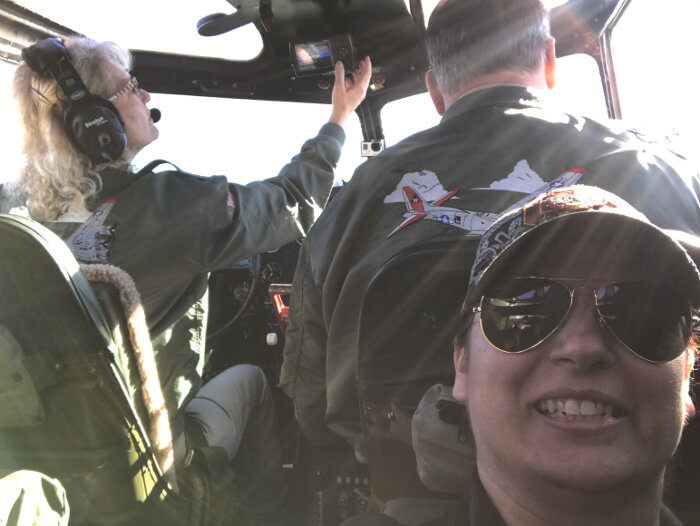
This past weekend I had the pleasure of taking a ride in the EAA’s restored B-17 bomber the “Aluminum Overcast”. It was an amazing experience. A rare look into what our WWII Soldier’s, Airmen, and Marines experienced. The restoration only allowed for a few additional seats (for tour flights) and upgraded electronics. Other than that it is the way it was off the line.
B-17 History
The B-17 is a Boeing aircraft first produced in 1935. The B in the designation stands for Boeing, not bomber as is often guessed. It went through several iterations over the production years and finished with the -G model.
Though it failed and fatally crashed its demonstration flight for the Army in 1935, the US Army Air Corps (USAAC), which became the US Army Air Force (USAAF) was still significantly impressed that they ordered 13 for testing in a service environment. The crash was attributed to a gust lock that was left in place.
A reporter during the test flight exclaimed “Wow, its a flying fortress”. Capable of brandishing 13 .50 caliber machine guns for defense of the plane, the bigger firepower was the bombs they were carrying. Each machine gun only had 1 belt of bullets as they were not the primary offensive weapon of the war bird. Boeing was quick to capitalize on the compliment and ran with the name Flying Fortress.
During the 10 year production run of the B-17 over 12,000 were made. While only 13 were originally ordered, the request for more bombers quickly increased. The demand was more than Boeing could keep up with so they subcontracted out a portion of the planes to what is now Lockheed Martin.

One of the reasons for the success of the plane was the technological advances on board. The then-secret Norden Bombsight was an analog computer designed to calculate when to release the bombs to hit the desired target. This was very effective during the super secret test flights around 17,000 feet. However, the accuracy of the bombing missions went down during actual operations around 30,000+ feet. The technology was advanced for the time, but certainly not as accurate as we have today.
The fate of the more than 12,000 B-17’s is rather sad. 4,735 were lost to combat missions. With the advent of the jet age many B-17s were scrapped after the war in favor of the faster, stealthier planes. To date, there are only about 100 B-17 air frames that remain with much fewer than that in an airworthy condition. In fact, less than 15 are still capable of taking to the skies.
Wartime Workhorse
The reputation of the B-17 had it eventually operating in almost every combat zone of World War II.
During the war, the USAAF deployed the B-17 to Europe to bomb strategic German Industrial and Military targets. A hearty plane, it had a reputation to take a beating and still get the troops back home. It was also a work horse in the air. The B-17 is credited with the most bombs dropped during the war than any other type of aircraft. A little more than 1/3’d the total tonnage of bombs dropped during the war was from the B-17 model aircraft.
The 19th Bombardment group, which was operating out of the Philippines lost half of their B-17 fleet during the attack on Pearl Harbor. They were on a refueling and rearming stop and couldn’t become airborne fast enough.
The B-17 wasn’t as effective in the Pacific as it was over Europe. With such battles as the Battle of Midway and the Battle of Coral Sea the B-17 was hitting their targets about 1% of the time. Due to the nature of the fighting the order came to replace the Flying Fortress with a more capable bomber once the B-24 was made available.
EAA Aluminum Overcast

This beauty is a 1945 B-17G-VE. Delivered to the Army Air Force too late for the war it never saw combat, however it has been a great many things in its life.
It was purchased as army surplus in 1946 for $750. Talk about a real bargan for the buyer and a sucker punch to the tax payer. It was used as a cargo hauler, aerial mapper and forest duster as a few of its jobs.
It was bought by a B-17 restoration group in 1978 and they worked to restore it to its military glory. The cost of such an undertaking was overwhelming. They decided to donate it to the EAA in the hopes that the organization could finish what was started.
The Aluminum Overcast got its name one day while it was flying and a photographer was taking pictures in a plane underneath it. I think it was the pilot of the photography plane that was talking about an aluminum overcast layer as the B-17 blocked the sun for most of the trip. True or not that makes for a good naming story.
Flight Experience
The Aluminum Overcast is making several stops around the country. You can book a flight an the EAA’s website or even request a stop to be added.
The crew requests that you are at the flight location for check-in an hour early. This allows you to get all the paperwork finalized and finish up payment as needed. As well as plenty of time for your flight breifing and pictures.
You recieve a token plane ticket for your memorabilia box and a copy of the history of the Aluminmum Overcast as well as a copy of your flight briefing. After all, how many times can you say your flight’s emergency exits include the bomb bay doors?
After both a crew brief and then the pilot’s brief we were loaded up.
I was lucky to have the extra jump seat in the cockpit as my seat for the ride.


Once we were airborne our lead crew member allowed everyone to unbuckle and move about the plane. This was the best time to craw into the nose gunner’s pit.

Walk through the bomb area.

And see the view from the side machine guns.

After approximately 30 minutes of flight we were instructed to return to our seats as we headed back for the touchdown and taxi back to parking.
Boeing had one heck of a plane built and it was worth every penny to take a flight in such a historic plane.






